Remains of thescelosaurus in North Dakota believed to date back to extinction of species 66m years ago

A Thescelosaurus neglectus. The dig has been filmed for a BBC documentary.
Photograph: Jocelyn Augustino/The Guardian
Kevin Rawlinson
Kevin Rawlinson
Thu 7 Apr 2022 11.28 BST
Scientists believe they have been given an extraordinary view of the last day of the dinosaurs after they discovered the fossil of an animal they believe died that day.
The perfectly preserved leg, which even includes remnants of the animal’s skin, can be accurately dated to the time the asteroid that brought about the dinosaurs’ extinction struck Earth 66m years ago, experts say, because of the presence of debris from the impact, which rained down only in its immediate aftermath.
“It’s absolutely bonkers,” said Phillip Manning, a professor of natural history at the University of Manchester. He told BBC Radio 4’s Today programme the thescelosaurus leg discovered at the Tanis dig site in North Dakota was the “ultimate dinosaur drumstick”.

Mystery owner of Stan the T rex finally revealed following $31.8m auction
He said: “The time resolution we can achieve at this site is beyond our wildest dreams … This really should not exist and it’s absolutely gobsmackingly beautiful. I never dreamt in all my career that I would get to look at something a) so time-constrained; and b) so beautiful, and also tells such a wonderful story.”
The dig has been filmed for a BBC documentary Dinosaurs: The Final Day with Sir David Attenborough; during which the broadcaster will review the fossil finds. “When Sir David looked at ‘[the leg], he smiled and said ‘that is an impossible fossil’. And I agreed,” Manning said.
He said the team had also discovered the remains of fish that had breathed in impact debris from the asteroid strike, which occurred 1,864 miles (3,000km) away in the Gulf of Mexico.
That and the presence of other debris that rained down for a specific period immediately after the asteroid strike allowed them to date the site much more accurately than standard carbon dating techniques.
Robert DePalma, the University of Manchester graduate student who is leading the Tanis dig, said: “We’ve got so many details with this site that tell us what happened moment by moment, it’s almost like watching it play out in the movies. You look at the rock column, you look at the fossils there, and it brings you back to that day.”
The BBC reported that the team had also found the fossilised remains of a turtle that was skewered by a wooden stake and small mammals and their burrows, as well as skin from a triceratops, a pterosaur embryo inside its egg and what scientists think could be a fragment from the asteroid impactor itself.
Scientists believe they have been given an extraordinary view of the last day of the dinosaurs after they discovered the fossil of an animal they believe died that day.
The perfectly preserved leg, which even includes remnants of the animal’s skin, can be accurately dated to the time the asteroid that brought about the dinosaurs’ extinction struck Earth 66m years ago, experts say, because of the presence of debris from the impact, which rained down only in its immediate aftermath.
“It’s absolutely bonkers,” said Phillip Manning, a professor of natural history at the University of Manchester. He told BBC Radio 4’s Today programme the thescelosaurus leg discovered at the Tanis dig site in North Dakota was the “ultimate dinosaur drumstick”.

Mystery owner of Stan the T rex finally revealed following $31.8m auction
He said: “The time resolution we can achieve at this site is beyond our wildest dreams … This really should not exist and it’s absolutely gobsmackingly beautiful. I never dreamt in all my career that I would get to look at something a) so time-constrained; and b) so beautiful, and also tells such a wonderful story.”
The dig has been filmed for a BBC documentary Dinosaurs: The Final Day with Sir David Attenborough; during which the broadcaster will review the fossil finds. “When Sir David looked at ‘[the leg], he smiled and said ‘that is an impossible fossil’. And I agreed,” Manning said.
He said the team had also discovered the remains of fish that had breathed in impact debris from the asteroid strike, which occurred 1,864 miles (3,000km) away in the Gulf of Mexico.
That and the presence of other debris that rained down for a specific period immediately after the asteroid strike allowed them to date the site much more accurately than standard carbon dating techniques.
Robert DePalma, the University of Manchester graduate student who is leading the Tanis dig, said: “We’ve got so many details with this site that tell us what happened moment by moment, it’s almost like watching it play out in the movies. You look at the rock column, you look at the fossils there, and it brings you back to that day.”
The BBC reported that the team had also found the fossilised remains of a turtle that was skewered by a wooden stake and small mammals and their burrows, as well as skin from a triceratops, a pterosaur embryo inside its egg and what scientists think could be a fragment from the asteroid impactor itself.
No comments:
Post a Comment